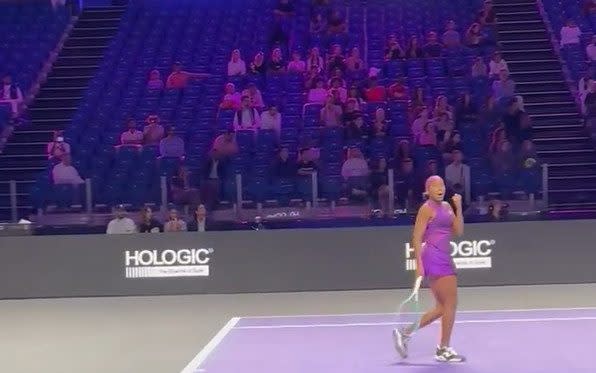
Tim Henman has become the latest tennis legend to question the staging of the WTA Finals in Saudi Arabia, although his concerns focused less on sportswashing than the absence of spectators in the stands.
Henman – the former British No 1 who now commentates for Sky Sports – was among the frustrated observers as the second day of the WTA Finals drew an embarrassingly tiny crowd of around 400 spectators, reopening the debate about the decision to bring elite tennis to Riyadh.
Until now, the conversation has mainly revolved around the moral arguments for and against this ground-breaking event. The 1980s giants Chris Evert and Martina Navratilova declined to attend after calling the choice of Saudi Arabia “a significant step backwards, to the detriment of the WTA, women’s sports and women”.
But the eight players who qualified have presented a united front. They insist that the tournament will be a force for good, arguing that the presence of so many independent female athletes can inspire local women in a country that ranks 126th out of 146 on the Global Gender Gap Index.
For such lofty aspirations to be realised, however, there need to be people – preferably women – in the stands to watch. On Sunday, the 5,000-seat stadium was less than 10 per cent full, despite the cheapest tickets costing no more than 30 Riyals (£6). The shortfall raised a different sort of question: can Saudi Arabia justify hosting a tournament of this scale for the full three-year contract if there is no interest among locals?
Also, could there potentially be a structural issue with women’s sport in Saudi Arabia? When Riyadh hosted the Six King’s Slam exhibition event at a nearby venue three weeks ago, the 8,000 seats were largely full for matches involving Rafael Nadal, Novak Djokovic and Jannik Sinner. It seems plausible that, just as female citizens of the Kingdom are legally dependent on their male guardians, women’s sports are also considered to be second class.
“There’s been plenty of debate over whether sporting events should be coming to Saudi Arabia,” said Henman, “but if we move past that and just look at this WTA Finals as an event, it’s extremely disappointing when you’ve got the world’s best players – Iga Swiatek, Coco Gauff – performing in front of a crowd like that today.
“The organisers here are in a privileged position where they’re not trying to necessarily make money out of the gate receipts. So they should get out into the communities and into the schools, because we need spectators here to witness the best players and create that atmosphere.”
After the first match of the day, in which Swiatek beat Barbora Krejcikova in three sets, Krejcikova told reporters that “There weren’t that many fans but they made nice atmosphere.”
Later, Coco Gauff handed a 6-3, 6-2 beatdown to her friend, compatriot and sometime doubles partner Jessica Pegula. Gauff then explained that: “Anytime there’s something new in a region, I don’t expect the crowd to be full. It’s just part of growing the game. Look at the WNBA [women’s basketball league]. Those stands probably weren’t as full a few years back, and now they’re full for all the teams. So I think it’s just growing pains.”


Pegula was also sanguine as she said: “We’ve played many matches where there’s not many people. We’ve played all through Covid where there was nobody.”
But Sky Sports commentator Jonathan Overend pointed out on air that there are numerous countries in the world where the likes of Swiatek – a three-time major champion and former world No1 – would draw a significant crowd without any need for educating the local population in the attractions of the game.
In a statement, the WTA made the same point as Gauff, saying “We’re bringing tennis to a new audience and that takes time to build.” It also emphasised the “strong attendance at the opening day” and added that “We always anticipated lower attendance with the start of the Saudi working week on Sunday but anticipate that numbers will build as we approach the weekend.”
The atmosphere had certainly been lively during Saturday’s opening singles match between Qinwen Zheng and Aryna Sabalenka, which the Belorussian won 6-3, 6-4 to extend her 100 per cent record against the Olympic champion.
‘The crowd was almost non-existent’
The stands were at least 70 per cent full for that match, with a Chinese majority that left Qinwen feeling like she was playing at home. However, numbers fell for Saturday’s evening match between Jasmine Paolini and Elena Rybakina, while the doubles barely registered.
On Sunday, organisers were quick to mention that students are busy with exams in Riyadh – a disadvantage for an event staged at King Saud University’s indoor arena. It is expected, however, that the next four days will also see small crowds until numbers pick up again on Friday.
The previous two editions of WTA Finals, held in Texas two years ago and Cancun last year, both also suffered from poor attendances. But there was more of an excuse in those cases.
“Texas and Cancun were both arranged at the last minute,” said Henman, “whereas the announcement of Riyadh came back in April.
“I think the organisers have got to look at the lack of fans. The way that they’ve built the facility and looked after the players has been really impressive. But the allocation of tickets – I don’t think you can even call it a ticket sale, when this isn’t really a commercial operation – needs to be taken more seriously. Today, the crowd was almost non-existent.”
